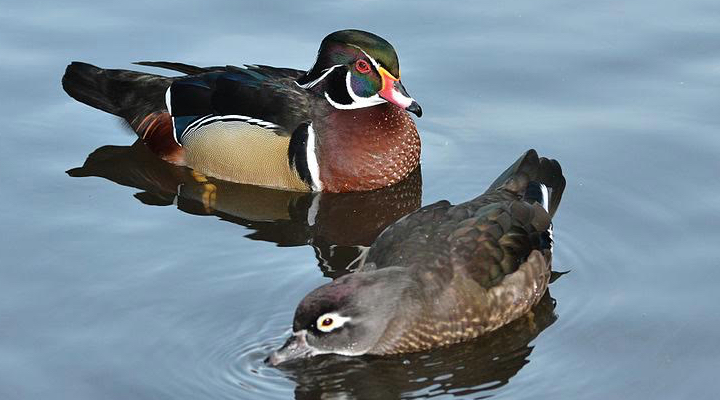They are small, fast-flying ducks that test the wing shooting skills of Kentucky waterfowl hunters.
Wood ducks and teal may be hunted during an early season, which opens Sept. 19.
A change in the season time frame now means there will be two consecutive weekends that ducks may be hunted — a five-day wood duck season, Sept. 19-23, and a nine-day teal season, Sept. 19-27.;
Wood Duck Season
Early wood duck season is for locally produced birds. That was the major justification for the early season — that Kentucky raised a lot of wood ducks, but hunters were able to harvest relatively few of them. Most of the wood ducks taken during the winter duck season are migrants from northern states.
“There are so many opportunities to hunt wood ducks throughout the state,” said John Brunjes, migratory bird program coordinator for the Kentucky Department of Fish and Wildlife Resources (KDFWR).

The early season has become especially popular in Central and Eastern Kentucky, where hunters are more likely to encounter more wood ducks than teal. Wood ducks are hunted in wooded creek bottoms, wetlands, big rivers, and lakes that have flooded timber.
An annual brood survey, conducted on Kentucky rivers and streams each summer by KDFWR personnel, is used to monitor wood duck reproduction.
A wood duck banding program also provides important data on the birds. Wood ducks caught with rocket nets for banding, are aged and sexed to further quantify reproductive success and population dynamics. Band returns help biologists map migration routes.
“We band about 2,400 wood ducks,” said Brunjes. “We’re the only state to meet or exceed our wood duck banding quota every year.”
The season’s popularity has withstood the test of time. Hunter participation during the early wood duck season is good, Brunjes said, “with about 55 percent of the harvest occurring during the opening weekend.”
Kentucky, Tennessee and Florida are the only states that have an early wood duck season. The season started in 1981.
Species Profile
The wood duck (Aix sponsa) is a medium-sized duck, weighing about 1 1/2 pounds, with adults measuring about 17 to 20 inches long. Broad, relatively short wings enable the “woodie” to made acrobatic twists and turns while flying through timber.
Wood ducks are cavity nesters, raising their young in trees along creeks, rivers and wetlands. The average clutch size is 10 to 15 eggs.
In the summer both sexes of wood ducks are in eclipse plumage, a drab grayish-brown coloration, but the adult male’s winter plumage is a magnificent blend of green, rust, yellow, black, and tan, accented with white.
Blue-Winged Teal Migrate Earlier, Winter Farther South
During Kentucky’s September teal season, which was lengthened to nine days last year, hunters are most likely to encounter blue-winged teal while hunting on big rivers in far western Kentucky.
“Other states in the Mississippi and Central flyways have early teal only seasons,” said Brunjes.
A harvest assessment found that Kentucky hunters weren’t taking very many of these early-migrating teal, that begin their long migration south during the dog days of August.
Mature drakes are typically first to leave their breeding grounds in the northern U.S. and Canada, followed by adult hens and juvenile birds. By Labor Day, large flights of teal are on the move, riding the cool winds of early cold fronts.
The migration habits of blue-winged teal set them apart from other North American waterfowl. They not only migrate earlier than other waterfowl species, including the more cold-tolerant green-winged teal, but they also journey faster and farther from their breeding grounds. Many bluewings blow through the U.S. in a matter of days, stopping only briefly along the way to feed and rest.
The majority of the population follows the Central and Mississippi flyways. A small number winter in the extreme southern U.S., but most of the birds continue flying south to Mexico, Latin America, and the Caribbean.
Bag Limits
The early wood duck and teal season has a six-bird daily bag limit, but no more than two birds may be wood ducks. For details on hunting regulations consult the 2015 migratory bird guide here.
Harvest Information Program Survey Required
Licensed waterfowl hunters, who plan to hunt, are required to go online or make a phone call and fill out the Harvest Information Program (HIP) questionnaire before hunting.
Go to fw.ky.gov, click on the “My Profile” tab. This takes hunters to a page that asks for some basic information to confirm their identity.
After completing the HIP questions, hunters receive a confirmation number that must be written on your hunting license or Kentucky Migratory Game Bird-Waterfowl Hunting Permit.
Hunters can also take the HIP survey over the telephone by calling 1-800-858-1549, 8:00 a.m. to 4:30 p.m., weekdays.
Art Lander Jr. is outdoors editor for KyForward. He is a native Kentuckian, a graduate of Western Kentucky University and a life-long hunter, angler, gardener and nature enthusiast. He has worked as a newspaper columnist, magazine journalist and author and is a former staff writer for Kentucky Afield Magazine, editor of the annual Kentucky Hunting & Trapping Guide and Kentucky Spring Hunting Guide, and co-writer of the Kentucky Afield Outdoors newspaper column.





















